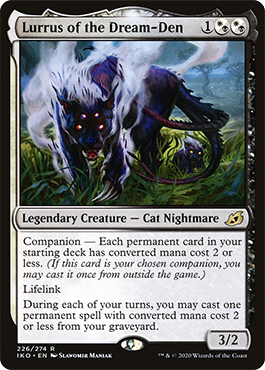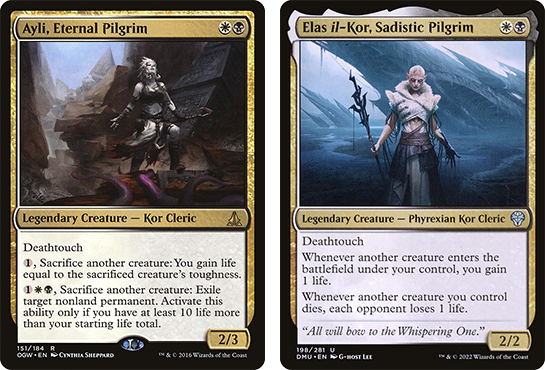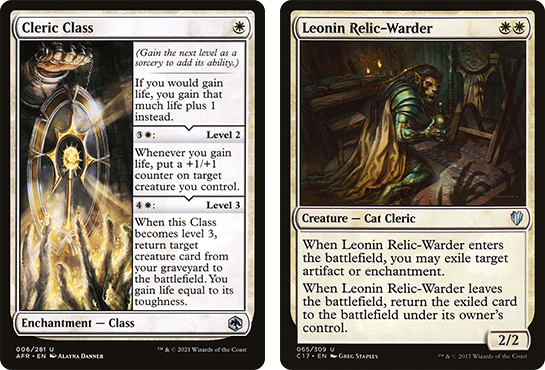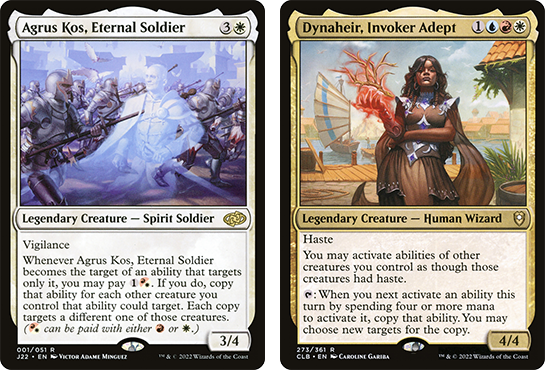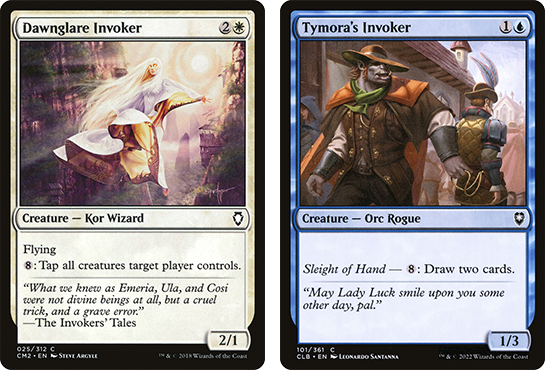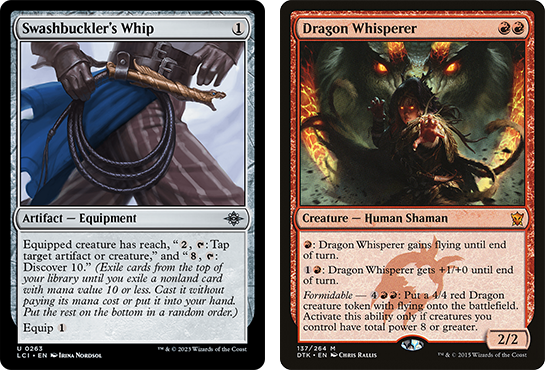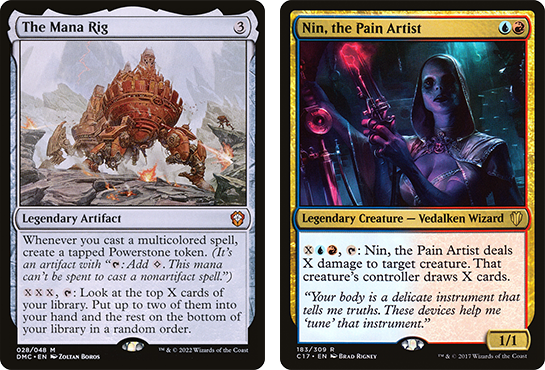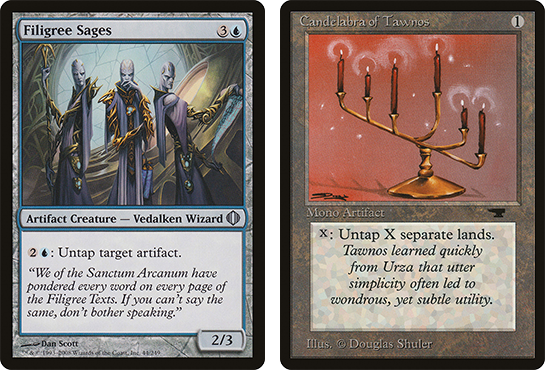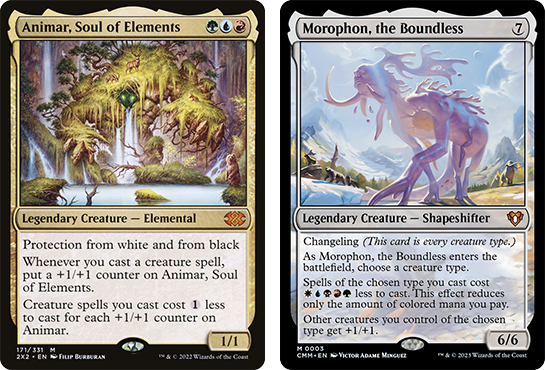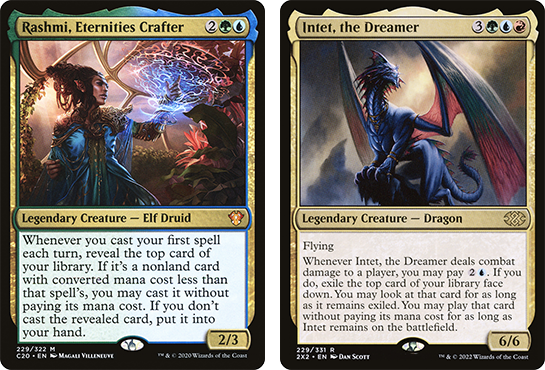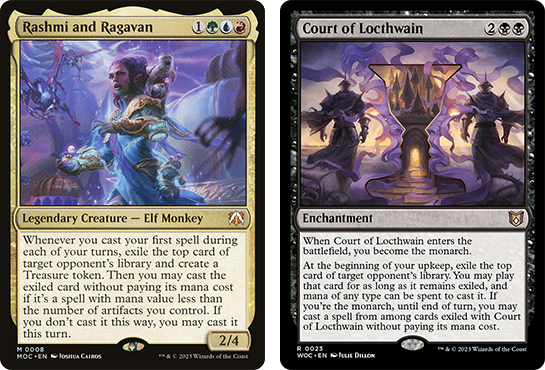It feels a little strange to say that Commander players are overlooking the Ikoria companions. After all, very few cards in Magic history have ever felt the spotlight so brightly as that ten-card cycle!
In their heyday, they inspired such unprecedented moves as the first balance-motivated ban in Vintage, a card being preemptively banned in Commander prior to release, and an entire mechanic being significantly reworked via official errata. It was messy stuff to say the least. But in hindsight, it’s hard to argue that those desperate measures worked, and the companions have settled into a more sustainable role across most formats.
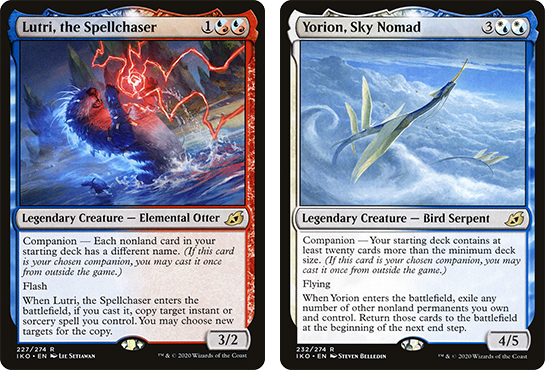
Lutri – hard banned. Yorion – not banned, but can’t use as a companion in Commander.
But what about Commander? Other than the outlawed Lutri, Commander players have just as much access to these potent pets as anyone else. They’re already used to this kind of narrow deckbuilding restriction and digging up niche cards to fulfill them.
Perhaps that similarity is the problem, and people are worried that taking a companion will overshadow or restrict the themes of their actual commander. But that is simply not the case – and I have these novel companion-centric deck ideas to prove it.
LURRUS OF THE DREAM-DEN
Arguably the strongest of the cycle and one of the absolute best cards ever printed, the restriction to unlock Lurrus as a companion is actually a lot more meaningful in Commander than in competitive Constructed. Our commander must cost two mana or less (and have WB in their color identity), which immediately narrows down our options. Avoiding expensive permanents is also much harder given that multiplayer tends to incentivize permanent-centric play, and that the ability to generate and use large sums of mana is often important.
Obviously there are plenty of strong permanents that cost two or less – in fact, stronger cards are more likely to get in under the limit. But can we find enough copies of our key pieces to actually have a consistent, powerful gameplan? Even strong cheap spells tend to be built for efficiency over impact, so inherently expensive, game changing effects like card draw or value-multiplying triggers will be hard to find.
Given we’re in white-black you could probably go all-in on tutors, combo pieces, discard and removal and just hope to sneak a fast win. But I don’t think many players really find that style exciting unless you can also couch it within a more multi-dimensional, coherent theme.
For instance, my personal Lurrus deck is a WB Clerics list led by Ayli, Eternal Pilgrim. Many powerful hatebears and utility creatures we can play with Lurrus have the Cleric type, and they also lend themselves well to themes of sacrifice, recursion and lifegain which fit with Ayli. Abilities like deathtouch and protection go a long way to bridging the gap between our tiny creatures and more expensive threats, as does white’s equipment package with Stoneforge Mystic and Puresteel Paladin.
The equipment and the Paladin also support one of a few non-combat wincons which fit with our companion and theme – Daru Spiritualist combo. It may not be the most efficient combo kill by 2024 standards, but we have several different ways to give a Cleric infinite toughness and then convert that to either a kill or at least infinite lifegain.
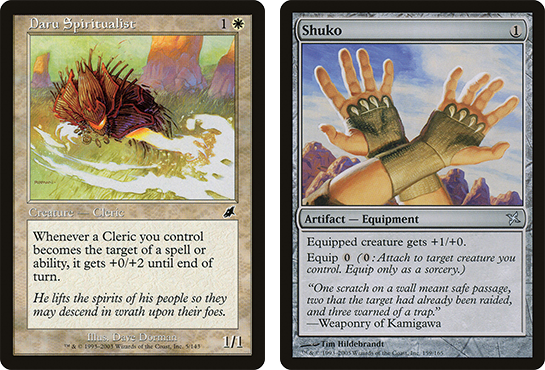
The lifegain theme extends to include a Soul Sisters package, giving even more “fair” ways to boost our creatures. Archangel of Thune is off limits, but we can play Cleric Class, Serene Steward, Ajani’s Pridemate, and various lookalikes. This also means we’re able to fit in another sneaky combo where we loop Dance of the Dead or Animate Dead on Leonin Relic-Warder to get infinite ETB triggers and hopefully win with a very large creature (or Elas il-Kor).
It’s a scrappy style to play, but between the natural disruptiveness of the hatebears, the card advantage provided by recursion and the pressure of mixed combat and combo wincons, you end up with a very flexible and fun shell to play that thrives on Lurrus’s aid. Now, how can we repeat that formula for some of the less-heralded companions?
ZIRDA, THE DAWNWAKER
I think Zirda is probably my favorite companion overall – the original artwork looks very cool, I like to explore non-combat effects in RW, and both the restriction and reward offered are reasonably balanced. Compared to Lurrus, I would say that building around Zirda forces you to look more outside of the most common staples, but you’re more likely to end up with a deck which plays like a “normal” Commander list.
Zirda requires our commander to have an activated ability (along with every other permanent). For the sake of synergy, we probably want that ability to be very impactful and expensive, or we want a commander to further incentivize the activated abilities we’re using on our other cards. A few standout choices include Kenrith, the Returned King, Agrus Kos, Eternal Soldier, Tazri, Stalwart Survivor, and Dynaheir, Invoker Adept. I personally would rather have synergies with noncreature cards than five-color access, so Dynaheir is my pick – but it’s truly a matter of preference.
The nice part of this companion/commander pair is that sometimes you’re explicitly looking for cards which explicitly synergize with both of them, but other times it’s enough just to find a card which does what you need and has cycling or some other incidental activated ability to keep Zirda happy.
In terms of maximizing value, we can really tap into a subset of permanents which have very cheap casting costs and very expensive activated abilities – these are often called “Invokers” after the Legions cycle, and I don’t think Dynaheir being an “Invoker Adept” is a coincidence.
If we’re willing to pay a higher upfront casting cost, we can start to discount and abuse some extremely powerful abilities – Twinning Staff, Helvault, Orthion, Hero of Lavabrink, or Tower of Fortunes. There’s not a lot of cards with activated abilities which cost six or more (and thus benefit from both Zirda and Dynaheir’s effects simultaneously), but there ARE plenty of X-cost activated abilities which will do the job fine. The Mana Rig, Alquist Proft, Master Sleuth, Nin, the Pain Artist, Tameshi, Reality Architect, and many others can really make use of this discounted double-activation sweet spot!
The only other question is how to pay for these hefty activation costs – and while mana abilities are deliberately exempted from both Zirda and Dynaheir’s effects, that doesn’t mean that we can’t still abuse them to boost our total mana output. The most famous example is the easy infinite Zirda has with either Basalt Monolith or Grim Monolith – untapping a Monolith isn’t a mana ability, it just happens to control how often we can use the attached mana ability.
Most of the time we aren’t so lucky as to find both parts of this one-two combo on the same card, but the general principle of using our synergies to indirectly break mana-producing effects is one you can go pretty deep on.
KERUGA, THE MACROSAGE
One of the most impactful deckbuilding restrictions among all companions is Keruga’s high-cost-only rule. Unlike Zirda and Lurrus, this hippo will not let us off the hook when it comes to non-permanent spells. And while Lurrus cutting us off from high-cost plays can complicate some parts of our gameplan, trying to play the game without any cheap cantrips, removal or mana ramp is a LOT worse. Taking the first three turns off is crippling, and later on it’s still difficult to double-spell or hold up interaction with such clunky mana costs.
The best thing we can do is try to run cards which have alternative casting modes, cost discounts or activated abilities that allow us to use them for less than three mana in spite of their printed cost. Delve, affinity, evoke, cycling, channel, split cards, MDFCs, adventures, madness, flashback, emerge… there’s tons and tons of mechanics to work with – and thank goodness, because we’ll need all the help we can get!
Speaking of help, the commander we choose to play here can make a huge impact on how we build around the Keruga restriction. One option is a commander who discounts our other spells, like Animar, Soul of Elements or Morophon the Boundless, or one which can give us free casts like Rashmi, Eternities Crafter, Intet, the Dreamer or Jodah, the Unifier.
A less obvious choice would be to play around a commander that gives us a discard outlet. This can make use of surplus expensive spells which we can’t afford to cast, and also ensures we get an immediate boost from Keruga’s ETB – which can otherwise be a little awkward in a deck that might already be struggling to use all its draws. Borborygmos and Fblthp, Indominus Rex, Alpha, and Jadzi, Oracle of Arcavios all fit the bill.
Our final way to compensate for Keruga’s restriction is to just steal cheap spells from other players’ decks, and use those as filler between our own jumbo-sized plays! This could be achieved through a commander like Rashmi and Ragavan, or just by stacking our 98 with cards like Stolen Strategy, Court of Lochthwain, Chaos Wand, Thief of Sanity, and Uvilda, Dean of Perfection//Nassari, Dean of Expression.
Each type of commander likely results in a very different route to Keruga success, but if you’re already committed to this companion then that likely strikes you as a positive, not a negative. Let your inner brewer run free!
NO LACK OF COMPANIONSHIP
Like I said earlier, building around the different companions feels very much like how players already approach their Commander decks. While there may not be actual rules to enforce it, I have many friends who self-impose limitations like “all my creatures have to be frogs” or “I’m not playing any instants” – either for the sake of theme, or just to force the deck in a more novel direction. Using companions gives you a material reward for your sacrifice, AND shows off what you’re doing right from the start so your opponents can appreciate it.
I only had space to cover a third of the current legal companion pool today, so perhaps in future we can revisit the topic and cover some of the cool options for playing around the others. It seems unlikely that Wizards would be interested in revisiting such a controversial mechanic to print more companions in future, but that doesn’t mean we need to give up on the ones we have. Adopt an Ikoria critter of your own today!

Tom’s fate was sealed in 7th grade when his friend lent him a pile of commons to play Magic. He quickly picked up Boros and Orzhov decks in Ravnica block and has remained a staunch white magician ever since. A fan of all Constructed formats, he enjoys studying the history of the tournament meta. He specializes in midrange decks, especially Death & Taxes and Martyr Proc. One day, he swears he will win an MCQ with Evershrike. Ask him how at @AWanderingBard, or watch him stream Magic at twitch.tv/TheWanderingBard.


